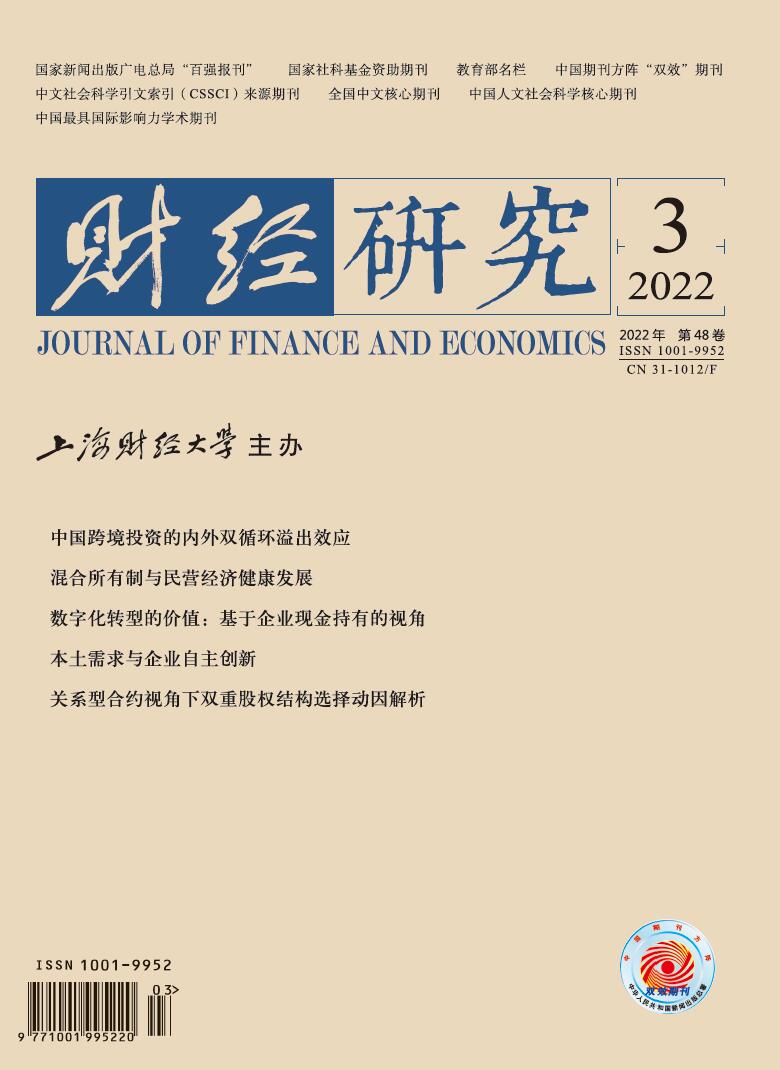供应链的资产专用性特征是否有利于企业进行商业信用融资?文章利用手工收集的独特供应链数据,从产品性质的维度构建供应链资产专用性指标,以2007—2019年沪深
供应链金融与企业商业信用融资——基于资产专用性的分析视角
摘要
参考文献
摘要
2 程新生,孙毅,刘翰. 控股股东行为、资产专用性与企业成长性−来自云南白药的案例研究[J]. 经济与管理研究,2012,(2):22−31. DOI:10.3969/j.issn.1000-7636.2012.02.003
4 惠双民. 资产专用性、网络扩展和私人秩序[J]. 经济研究,2002,(7):63−68. DOI:10.3969/j.issn.1005-913X.2002.07.029
5 雷新途,李世辉. 资产专用性、声誉与企业财务契约自我履行:一项实验研究[J]. 会计研究,2012,(9):59−66. DOI:10.3969/j.issn.1003-2886.2012.09.008
6 李青原,王永海. 资产专用性与公司资本结构−来自中国制造业股份有限公司的经验证据[J]. 会计研究,2006,(7):66−71. DOI:10.3969/j.issn.1003-2886.2006.07.010
7 李维安,李勇建,石丹. 供应链治理理论研究:概念、内涵与规范性分析框架[J]. 南开管理评论,2016,(1):4−15. DOI:10.3969/j.issn.1008-3448.2016.01.002
9 潘飞,文东华,段军山. 关联购销、价格管制及价值相关性研究−来自我国上市公司的经验证据[J]. 财经研究,2006,(5):60−69. DOI:10.3969/j.issn.1001-9952.2006.05.006
12 王晓文,田新,李凯. 供应链治理结构的影响因素分析−基于集中式外卖模式的案例研究[J]. 软科学,2009,(7):46−50. DOI:10.3969/j.issn.1001-8409.2009.07.010
14 王永贵,洪傲然. 千篇一律还是产品定制−“一带一路”背景下中国企业跨国渠道经营研究[J]. 管理世界,2020,(12):110−126. DOI:10.3969/j.issn.1002-5502.2020.12.010
15 王竹泉,翟士运,王贞洁. 商业信用能够帮助企业渡过金融危机吗[J]. 经济管理,2014,(8):42−53. DOI:10.3969/j.issn.1671-0975.2014.08.016
16 于富生,张敏,姜付秀,等. 公司治理影响公司财务风险吗[J]. 会计研究,2008,(10):52−59. DOI:10.3969/j.issn.1003-2886.2008.10.008
18 郑军,林钟高,彭琳. 高质量的内部控制能增加商业信用融资吗?−基于货币政策变更视角的检验[J]. 会计研究,2013,(6):62−68. DOI:10.3969/j.issn.1003-2886.2013.06.009
19 Allen F, Qian J, Qian M. Law, finance, and economic growth in China[J]. Journal of Financial Economics,2005,77(1): 57−116. DOI:10.1016/j.jfineco.2004.06.010
20 Altman E I. Financial ratios, discriminant analysis and the prediction of corporate bankruptcy[J]. The Journal of Finance,1968,23(4): 589−609. DOI:10.1111/j.1540-6261.1968.tb00843.x
21 Ayyagari M, Demirgüç-Kunt A, Maksimovic V. Formal versus informal finance: Evidence from China[J]. The Review of Financial Studies,2010,23(8): 3048−3097. DOI:10.1093/rfs/hhq030
22 Brunner A, Krahnen J P. Multiple lenders and corporate distress: Evidence on debt restructuring[J]. The Review of Economic Studies,2008,75(2): 415−442. DOI:10.1111/j.1467-937X.2008.00483.x
23 Bulte E, Xu L H, Zhang X B. Post-disaster aid and development of the manufacturing sector: Lessons from a natural experiment in China[J]. European Economic Review,2018,101: 441−458. DOI:10.1016/j.euroecorev.2017.10.019
24 Burkart M, Ellingsen T. In-kind finance: A theory of trade credit[J]. The American Economic Review,2004,94(3): 569−590. DOI:10.1257/0002828041464579
25 Chen Z H, Wang Z. Do firms obtain multiple ratings to hedge against downgrade risk?[J]. Journal of Banking and Finance,2021,123: 106006. DOI:10.1016/j.jbankfin.2020.106006
26 Chod J, Lyandres E, Yang A. Trade credit and supplier competition[J]. Journal of Financial Economics,2019,131(2): 484−505. DOI:10.1016/j.jfineco.2018.08.008
27 Cuñat V. Trade credit: Suppliers as debt collectors and insurance providers[J]. The Review of Financial Studies,2007,20(2): 491−527. DOI:10.1093/rfs/hhl015
28 Degryse H, Lu L P, Ongena S. Informal or formal financing? Evidence on the co-funding of Chinese firms[J]. Journal of Financial Intermediation,2016,27: 31−50. DOI:10.1016/j.jfi.2016.05.003
29 Fabbri D, Klapper L F. Bargaining power and trade credit[J]. Journal of Corporate Finance,2016,41: 66−80. DOI:10.1016/j.jcorpfin.2016.07.001
30 Ferris J S. A transactions theory of trade credit use[J]. The Quarterly Journal of Economics,1981,96(2): 243−270. DOI:10.2307/1882390
31 Fisman R. Trade credit and productive efficiency in developing countries[J]. World Development,2001,29(2): 311−321. DOI:10.1016/S0305-750X(00)00096-6
32 Giannetti M, Burkart M, Ellingsen T. What you sell is what you lend? Explaining trade credit contracts[J]. The Review of Financial Studies,2011,24(4): 1261−1298. DOI:10.1093/rfs/hhn096
33 Guariglia A, Mateut S. Credit channel, trade credit channel, and inventory investment: Evidence from a panel of UK firms[J]. Journal of Banking & Finance,2006,30(10): 2835−2856.
35 Kong D M, Pan Y, Tian G G, et al. CEOs’ hometown connections and access to trade credit: Evidence from China[J]. Journal of Corporate Finance,2020,62: 101574. DOI:10.1016/j.jcorpfin.2020.101574
36 Madestam A. Informal finance: A theory of moneylenders[J]. Journal of Development Economics,2014,107: 157−174. DOI:10.1016/j.jdeveco.2013.11.001
37 Petersen M A, Rajan R G. Trade credit: Theories and evidence[J]. The Review of Financial Studies,1997,10(3): 661−691. DOI:10.1093/rfs/10.3.661
38 Poppo L, Zenger T. Do formal contracts and relational governance function as substitutes or complements[J]. Strategic Management Journal,2002,23(8): 707−725. DOI:10.1002/smj.249
39 Rauch J E. Networks versus markets in international trade[J]. Journal of International Economics,1999,48(1): 7−35. DOI:10.1016/S0022-1996(98)00009-9
40 Smith J K. Trade credit and informational asymmetry[J]. The Journal of Finance,1987,42(4): 863−872. DOI:10.1111/j.1540-6261.1987.tb03916.x
41 Williamson O E. Transaction-cost economics: The governance of contractual relations[J]. The Journal of Law and Economics,1979,22(2): 233−261. DOI:10.1086/466942
42 Wilner B S. The exploitation of relationships in financial distress: The case of trade credit[J]. The Journal of Finance,2000,55(1): 153−178. DOI:10.1111/0022-1082.00203
43 Wilson N, Summers B. Trade credit terms offered by small firms: Survey evidence and empirical analysis[J]. Journal of Business Finance & Accounting,2002,29(3−4): 317−351.
44 Yang W, Li H Y, Kong G W, et al. Access to finance and SMEs’ trade credit: Evidence from a regression discontinuity design[J]. Accounting & Finance,2021,61(2): 2997−3029.
引用本文
王鲁昱, 李科. 供应链金融与企业商业信用融资——基于资产专用性的分析视角[J]. 财经研究, 2022, 48(3): 154-168.
导出参考文献,格式为:





 7661
7661  12104
12104

